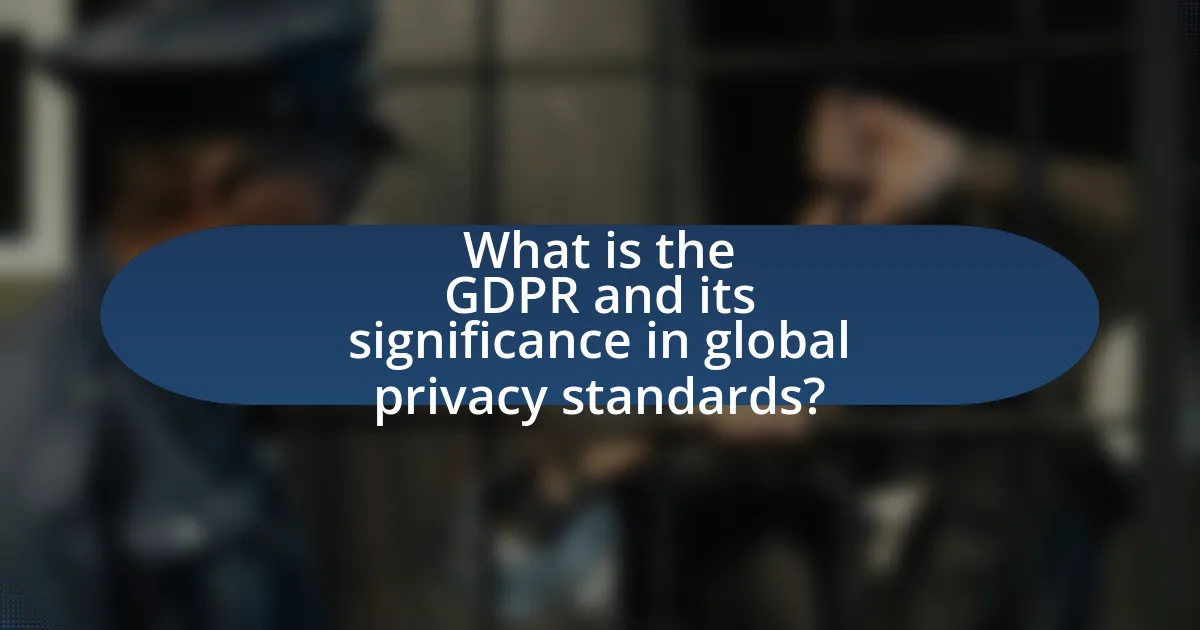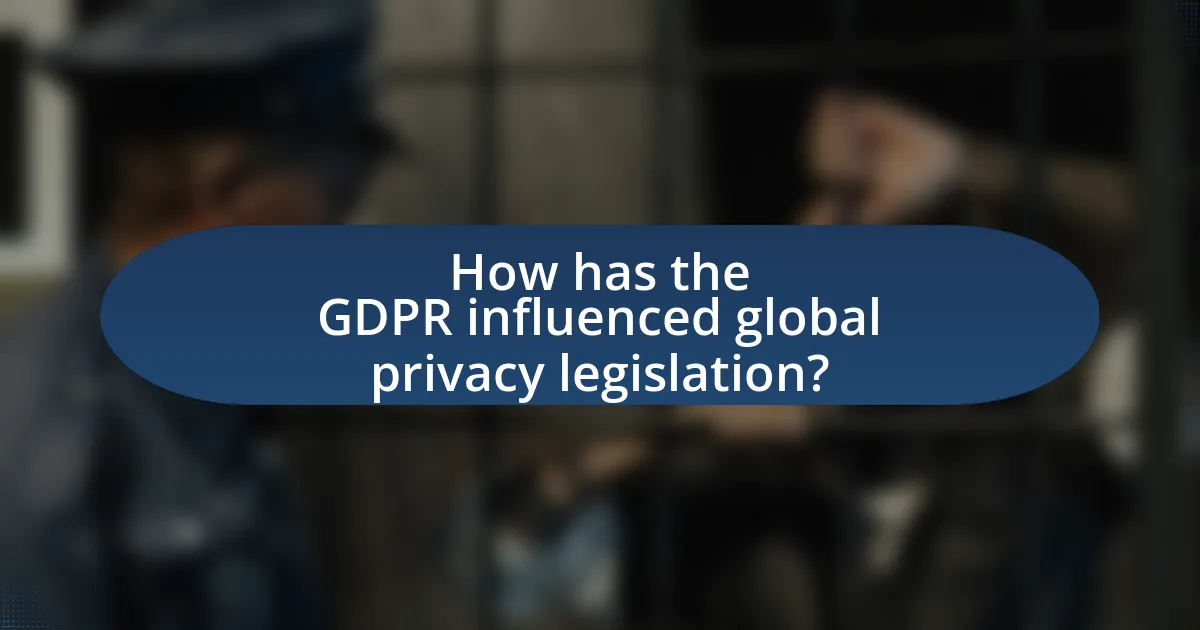The General Data Protection Regulation (GDPR) is a pivotal data protection law enacted by the European Union in May 2018, aimed at enhancing individual control over personal data and establishing stringent requirements for data handling. This article examines the significance of the GDPR in shaping global privacy standards, its motivations for implementation, and its core principles, including individual rights and data protection by design. It also explores the impact of the GDPR on businesses worldwide, the challenges faced in compliance, and how it has influenced privacy legislation in non-EU countries. Additionally, the article discusses potential future developments of the GDPR in response to technological advancements and offers best practices for organizations to ensure compliance.

What is the GDPR and its significance in global privacy standards?
The General Data Protection Regulation (GDPR) is a comprehensive data protection law enacted by the European Union in May 2018, designed to enhance individuals’ control over their personal data. Its significance in global privacy standards lies in its stringent requirements for data handling, including principles of transparency, consent, and the right to access and delete personal information. The GDPR has influenced privacy legislation worldwide, prompting countries to adopt similar frameworks to protect citizens’ data, thereby raising the global standard for privacy rights and data security. For instance, countries like Brazil and California have implemented laws inspired by the GDPR, reflecting its role as a benchmark for privacy regulations.
How did the GDPR come into existence?
The General Data Protection Regulation (GDPR) came into existence as a response to the need for stronger data protection laws in the European Union. The European Commission proposed the GDPR in January 2012, aiming to harmonize data privacy laws across Europe and enhance individuals’ control over their personal data. The regulation was adopted on April 14, 2016, and became enforceable on May 25, 2018, reflecting the growing concerns about data privacy in the digital age, particularly following incidents like the 2013 revelations about mass surveillance by the NSA. The GDPR established comprehensive guidelines for the collection and processing of personal information, setting a global benchmark for privacy standards.
What were the key motivations behind the GDPR’s implementation?
The key motivations behind the GDPR’s implementation were to enhance individual privacy rights and to create a unified data protection framework across Europe. The regulation aimed to address growing concerns about data misuse and privacy violations, particularly in the wake of high-profile data breaches and the rapid expansion of digital technologies. The GDPR established stringent requirements for data handling, consent, and transparency, reflecting the need for stronger protections in an increasingly data-driven world. This was further supported by the recognition that existing data protection laws were fragmented and inadequate to cope with the challenges posed by globalization and technological advancements.
How does the GDPR differ from previous privacy regulations?
The General Data Protection Regulation (GDPR) differs from previous privacy regulations primarily through its comprehensive scope and stringent enforcement mechanisms. Unlike earlier regulations, GDPR applies to all organizations processing personal data of individuals within the European Union, regardless of the organization’s location, thereby establishing a global standard for data protection. Additionally, GDPR introduces significant penalties for non-compliance, with fines reaching up to 4% of annual global turnover or €20 million, whichever is higher, which is a substantial increase compared to previous regulations. Furthermore, GDPR emphasizes the principles of data minimization, explicit consent, and the right to data portability, enhancing individual rights and control over personal data compared to earlier frameworks that lacked such robust provisions.
What are the core principles of the GDPR?
The core principles of the GDPR are lawfulness, fairness, and transparency; purpose limitation; data minimization; accuracy; storage limitation; integrity and confidentiality; and accountability. These principles guide the processing of personal data to ensure individuals’ rights are protected. For instance, the principle of lawfulness requires that data processing is based on a legal basis, such as consent or contractual necessity, while purpose limitation mandates that data is collected for specified, legitimate purposes and not further processed in a manner incompatible with those purposes. Each principle is designed to enhance data protection and privacy, reflecting the GDPR’s commitment to safeguarding personal information in the digital age.
What rights does the GDPR grant to individuals?
The General Data Protection Regulation (GDPR) grants individuals several key rights regarding their personal data. These rights include the right to access their data, the right to rectification, the right to erasure (also known as the right to be forgotten), the right to restrict processing, the right to data portability, and the right to object to processing.
Specifically, the right to access allows individuals to obtain confirmation of whether their personal data is being processed and to receive a copy of that data. The right to rectification enables individuals to request corrections to inaccurate or incomplete data. The right to erasure permits individuals to request the deletion of their personal data under certain conditions. The right to restrict processing allows individuals to limit how their data is used. The right to data portability gives individuals the ability to transfer their data from one service provider to another. Lastly, the right to object allows individuals to challenge the processing of their data for specific purposes, such as direct marketing.
These rights are established in Articles 15 to 22 of the GDPR, which came into effect on May 25, 2018, and represent a significant enhancement of individual privacy rights within the European Union.
How does the GDPR ensure data protection by design and by default?
The GDPR ensures data protection by design and by default through its requirement that organizations implement appropriate technical and organizational measures to integrate data protection into their processing activities from the outset. Article 25 of the GDPR explicitly mandates that data protection must be considered during the design phase of any system or process that handles personal data, ensuring that only necessary data is processed and that privacy settings are set at a high level by default. This means that organizations must proactively embed privacy features into their products and services, rather than treating data protection as an afterthought. The regulation also emphasizes the importance of minimizing data collection and retention, thereby reinforcing the principle of data minimization, which is a core tenet of effective data protection practices.
What impact has the GDPR had on businesses worldwide?
The General Data Protection Regulation (GDPR) has significantly impacted businesses worldwide by enforcing stricter data protection and privacy standards. Since its implementation in May 2018, companies operating in or with the European Union have had to invest heavily in compliance measures, leading to increased operational costs. For instance, a survey by the International Association of Privacy Professionals (IAPP) indicated that 60% of organizations reported spending more than $1 million on GDPR compliance. Additionally, the GDPR has prompted businesses globally to reevaluate their data handling practices, resulting in a shift towards greater transparency and accountability in data processing. This regulatory framework has also influenced other jurisdictions to adopt similar privacy laws, thereby raising global privacy standards.
How have companies adapted their data practices in response to the GDPR?
Companies have adapted their data practices in response to the GDPR by implementing stricter data protection measures and enhancing transparency in data handling. For instance, many organizations have established data protection officers, conducted comprehensive data audits, and revised privacy policies to ensure compliance with GDPR requirements. According to a report by the International Association of Privacy Professionals, 60% of companies have increased their investment in data protection technologies since the GDPR came into effect. Additionally, businesses have adopted practices such as obtaining explicit consent from users before processing their data and providing clear options for data access and deletion, reflecting a significant shift towards prioritizing user privacy and data security.
What challenges have businesses faced in compliance with the GDPR?
Businesses have faced significant challenges in compliance with the GDPR, primarily due to the complexity of the regulation and the extensive requirements it imposes. The GDPR mandates strict data protection measures, necessitating businesses to implement comprehensive data management practices, which can be resource-intensive and costly. For instance, organizations must conduct data audits, appoint Data Protection Officers, and ensure that consent mechanisms are robust and transparent. Additionally, the regulation’s extraterritorial scope means that non-EU businesses must also comply if they process data of EU citizens, complicating compliance efforts further. According to a survey by the International Association of Privacy Professionals, 60% of organizations reported difficulties in understanding GDPR requirements, highlighting the widespread confusion and the need for specialized legal and technical expertise.

How has the GDPR influenced global privacy legislation?
The General Data Protection Regulation (GDPR) has significantly influenced global privacy legislation by establishing a comprehensive framework for data protection that many countries have adopted or are in the process of adopting. The GDPR’s principles, such as data minimization, user consent, and the right to access personal data, have served as a model for countries like Brazil with its Lei Geral de Proteção de Dados (LGPD) and California with the California Consumer Privacy Act (CCPA). These regulations reflect GDPR’s emphasis on individual rights and organizational accountability, demonstrating its role as a catalyst for enhanced privacy standards worldwide.
What other countries have adopted GDPR-like regulations?
Countries that have adopted GDPR-like regulations include Brazil, with its General Data Protection Law (LGPD), and California in the United States, which implemented the California Consumer Privacy Act (CCPA). Brazil’s LGPD, enacted in 2018, mirrors many principles of the GDPR, such as data subject rights and the requirement for consent. Similarly, the CCPA, effective from January 2020, provides California residents with rights regarding their personal information, reflecting GDPR’s emphasis on consumer privacy. Other countries, such as Canada with its Personal Information Protection and Electronic Documents Act (PIPEDA), also align closely with GDPR principles, enhancing global privacy standards.
How do these regulations compare to the GDPR?
These regulations often align closely with the GDPR in terms of data protection principles, but they may differ in specific requirements and enforcement mechanisms. For instance, while the GDPR mandates explicit consent for data processing, some regulations allow for implied consent under certain conditions. Additionally, the GDPR imposes strict penalties for non-compliance, with fines reaching up to 4% of global annual turnover, whereas other regulations may have less severe financial repercussions. This comparison highlights the GDPR’s role as a benchmark for global privacy standards, influencing many jurisdictions to adopt similar frameworks while also allowing for regional variations in implementation and enforcement.
What lessons have been learned from the GDPR’s implementation in other jurisdictions?
The implementation of the GDPR has taught jurisdictions several key lessons regarding data protection and privacy. Firstly, the necessity of clear and comprehensive regulations is evident, as jurisdictions that adopted similar frameworks experienced improved compliance and accountability among organizations. For instance, countries like Brazil and California have enacted laws inspired by GDPR principles, leading to enhanced consumer trust and data security. Additionally, the importance of robust enforcement mechanisms has been highlighted; jurisdictions with strong penalties for non-compliance saw higher adherence rates. The GDPR’s emphasis on user consent has also underscored the need for transparency in data processing, prompting other regions to prioritize user rights in their legislation. These lessons demonstrate that adopting GDPR-like frameworks can lead to significant advancements in global privacy standards.
Why is the GDPR considered a benchmark for privacy standards?
The GDPR is considered a benchmark for privacy standards because it establishes comprehensive regulations that protect personal data and privacy rights of individuals within the European Union. This regulation, implemented in May 2018, sets a high standard for data protection by mandating explicit consent for data processing, enhancing individuals’ rights to access and control their personal information, and imposing significant penalties for non-compliance, which can reach up to 4% of a company’s global annual revenue. The GDPR’s influence extends beyond Europe, prompting countries worldwide to adopt similar privacy laws, thereby shaping global privacy standards and practices.
What role does the GDPR play in shaping international data transfer agreements?
The GDPR establishes strict requirements for international data transfers, significantly influencing global data transfer agreements. It mandates that personal data can only be transferred outside the European Economic Area if the receiving country ensures an adequate level of data protection, as determined by the European Commission. This requirement has led to the creation of various frameworks, such as the Privacy Shield and Standard Contractual Clauses, which aim to align international practices with GDPR standards. The GDPR’s emphasis on data subject rights and accountability has prompted countries and organizations worldwide to enhance their data protection laws and practices, thereby shaping a more uniform global approach to privacy standards.
How has the GDPR affected the development of privacy laws in non-EU countries?
The General Data Protection Regulation (GDPR) has significantly influenced the development of privacy laws in non-EU countries by setting a global benchmark for data protection standards. Countries such as Brazil and California have enacted laws that mirror GDPR principles, emphasizing user consent, data portability, and the right to be forgotten. For instance, Brazil’s Lei Geral de Proteção de Dados (LGPD), which came into effect in 2020, closely aligns with GDPR requirements, reflecting the regulation’s impact on shaping international privacy frameworks. Additionally, many nations are revising their privacy legislation to enhance compliance with GDPR-like standards, recognizing the importance of data protection in an increasingly digital world.

What are the future implications of the GDPR on global privacy standards?
The future implications of the GDPR on global privacy standards include the establishment of stricter data protection regulations worldwide. As countries observe the effectiveness of the GDPR in enhancing consumer privacy and holding organizations accountable, many are likely to adopt similar frameworks. For instance, the California Consumer Privacy Act (CCPA) mirrors several GDPR principles, indicating a trend towards comprehensive privacy laws. Furthermore, the GDPR’s extraterritorial reach encourages non-EU countries to align their regulations with its standards to facilitate international trade and data exchange. This shift is evidenced by the increasing number of nations implementing or revising their privacy laws to reflect GDPR-like protections, thereby promoting a more unified global approach to data privacy.
How might the GDPR evolve in response to technological advancements?
The GDPR may evolve by incorporating more specific regulations addressing emerging technologies such as artificial intelligence and blockchain. As these technologies develop, the need for clearer guidelines on data processing, consent, and user rights will become essential to ensure compliance and protect individual privacy. For instance, the European Data Protection Board has already indicated that AI systems must adhere to GDPR principles, emphasizing transparency and accountability in automated decision-making processes. This evolution will likely include updates to definitions of personal data and the introduction of new rights for individuals, reflecting the changing landscape of data usage and privacy concerns.
What potential changes could be made to the GDPR in the coming years?
Potential changes to the GDPR in the coming years may include adjustments to data portability requirements, enhanced provisions for artificial intelligence, and updates to consent mechanisms. The European Commission has indicated a focus on improving data subject rights, which could lead to more streamlined processes for individuals to access and transfer their data. Additionally, as AI technologies evolve, the GDPR may incorporate specific regulations addressing automated decision-making and profiling to ensure transparency and accountability. These potential changes reflect ongoing discussions within the EU regarding the need to adapt privacy regulations to emerging technologies and societal expectations.
How can businesses prepare for future updates to the GDPR?
Businesses can prepare for future updates to the GDPR by implementing a proactive compliance strategy that includes regular audits, staff training, and staying informed about regulatory changes. Regular audits help identify gaps in current data protection practices, ensuring alignment with evolving legal requirements. Staff training enhances awareness of data privacy principles and responsibilities, fostering a culture of compliance. Additionally, subscribing to legal updates and engaging with privacy professionals can provide insights into potential changes, allowing businesses to adapt their policies and procedures accordingly. This approach is validated by the fact that organizations that actively monitor and adjust to regulatory changes are better positioned to mitigate risks and avoid penalties.
What best practices can organizations adopt to ensure compliance with the GDPR?
Organizations can adopt several best practices to ensure compliance with the GDPR, including conducting regular data audits, implementing data protection by design and by default, and providing comprehensive training for employees on data privacy. Regular data audits help organizations identify what personal data they hold, how it is processed, and whether it is necessary, which aligns with GDPR’s accountability principle. Implementing data protection by design and by default ensures that data protection measures are integrated into processing activities from the outset, minimizing risks to individuals’ privacy. Additionally, training employees on GDPR requirements fosters a culture of compliance and awareness, reducing the likelihood of data breaches and non-compliance penalties. These practices are essential for organizations to navigate the complexities of GDPR and uphold individuals’ rights effectively.
How can companies effectively train employees on GDPR compliance?
Companies can effectively train employees on GDPR compliance by implementing a structured training program that includes comprehensive workshops, e-learning modules, and regular assessments. This approach ensures that employees understand the principles of data protection, the rights of individuals, and the responsibilities of the organization under GDPR. Research indicates that organizations that provide ongoing training and resources see a 30% increase in compliance awareness among employees. Additionally, incorporating real-life scenarios and case studies can enhance understanding and retention of GDPR concepts, making the training more relevant and practical.
What tools and resources are available to assist with GDPR compliance?
Various tools and resources are available to assist with GDPR compliance, including software solutions, guidelines, and training programs. Software tools such as OneTrust, TrustArc, and DataGrail help organizations manage data privacy assessments, consent management, and data subject requests. Additionally, the European Data Protection Board (EDPB) provides comprehensive guidelines and resources on GDPR compliance, including templates and checklists. Training programs offered by organizations like the International Association of Privacy Professionals (IAPP) equip professionals with the knowledge needed to navigate GDPR requirements effectively. These resources collectively support organizations in achieving and maintaining compliance with GDPR regulations.





